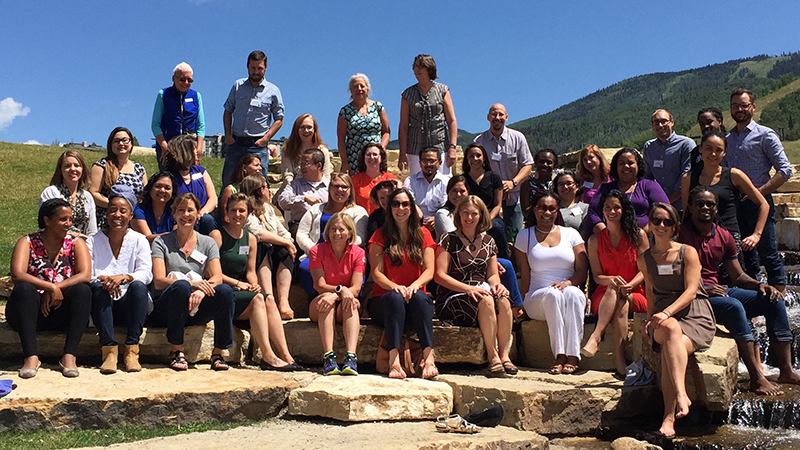Planting Seeds in a Long-Lasting Health Equity Field
Leer en español
A convening of the Health Equity Advocacy cohort members in Steamboat Springs, August 2016. Photo by Social Policy Research Associates
By Felisa Gonzales, PhD, MPH
The Colorado Trust recognizes the essential role of advocacy and policy change in achieving health equity for all Coloradans. To this end, The Colorado Trust’s Health Equity Advocacy (HEA) strategy aims to establish a field of health equity advocates who can strategically promote policy changes addressing social, economic and environmental determinants of health.
The efforts of the cohort of 18 direct service, community organizing and policy advocacy organizations funded through the HEA strategy in 2015 and 2016 are detailed in a new report by Social Policy Research Associates titled Toward Health Equity in Colorado: Progress and Lessons Learned in Health Equity Advocacy Field-Building. The report highlights key accomplishments by these organizations in the domains of capacity building, alignment and coordination, community engagement and power sharing, and vision setting.
Cultivating a health equity advocacy field—defined as an identifiable group of actors with a shared identity, knowledge base, vocabulary, policy and practice, operating in relationship with each other—is a long-term endeavor. Much of 2015 and 2016 was dedicated to organizational capacity-building and infrastructure development for the cohort of 18 HEA organizations. Organizations not only reflected on their own understanding and practices of health equity; they also built trusting relationships with each other and developed workable structures for collective action that will endure. In the last two years, “we did the really hard work for long-term change,” said Alice Pugh, executive director of HEA cohort member Full Circle of Lake County.
Building relationships and capacity allowed for greater alignment and coordination across health equity advocacy activities. For example, several organizations from both inside and outside the cohort participated in the Coalition for Immigrant Health, which was convened by the Center for Health Progress, a HEA cohort member. This coalition of immigrant rights groups, health policy advocates (including cohort members like the Colorado Center on Law & Policy and the Colorado Children’s Campaign) and immigrant direct-service providers initially sought to identify policy solutions to minimize barriers to health care access for immigrant populations. However, after listening to the fears of the immigrant community after the 2016 election, the Coalition shifted its focus from traditional health policy solutions to supporting driver’s licenses for undocumented immigrants.
Engaging populations most impacted by health inequities, like immigrants, has been a central priority of the HEA strategy. Cohort members have sought to involve community members in health equity advocacy, identifying policy priorities and leadership trainings. The intentional inclusion of organizations from different sectors in the HEA cohort has facilitated the inclusion of community partners. As a case in point, Padres & Jóvenes Unidos shared their expertise in amplifying community voice and involvement with direct-service providers and policy advocacy organizations in the cohort.
The centering of racial equity in health equity advocacy was cited by several cohort organizations as one of the most important accomplishments of their work together thus far. This focus is codified in the vision statement developed by the HEA cohort: “Diverse Colorado leaders, united by common values and empowered communities, dismantle structural and racial inequities and build equitable systems so that all Coloradans can achieve their highest possible level of health.” This vision will continue to guide the HEA cohort in the years to come.
The full benefits of the field-building efforts completed by the HEA cohort so far are yet to be realized. In Pugh’s words:
The field is ready to plant. The field is tilled, the fences are built, but it takes time to reclaim forgotten land. With deep relationships, we created deep roots to solve really persistent social problems. Like the hardpan glacial till that is all around our mountains in Colorado, it is really hard to get things to grow. However, once those roots take hold, we have amazing plants like the bristlecone pine that lives for thousands of years. The HEA cohort and our field-building efforts came out much stronger, much more united, and longer lasting because of what we went through together in 2015 and 2016.”
We invite you to read the full report to learn more about “seeds” the HEA field planted in 2015 and 2016. Brief reports describing the HEA field-building strategy and the HEA evaluation framework can be found on our website. Please contact The Trust’s Research, Evaluation & Strategic Learning Manager Felisa Gonzales or Advocacy & Policy Partner Noelle Dorward for additional information.

